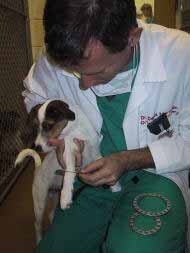New Approach Taken to Fix Limb Deformities
 |
Various rings are placed around the forelimb of a 5-month-old Jack Rusell terrier with an antebrachial deformity to assess future ring size. Photo provided by Denis Marcellin-Little. |
While some veterinarians shy away from limb deformity procedures that entail geometry and trigonometry, Denis Marcellin-Little, European College of Veterinary Surgeons, DACVS, associate professor of orthopedics at North Carolina State University’s College of Veterinary Medicine, embraces them. For the last 13 years, he has specialized in circular external fixation, a surgery that lengthens and straightens bones using external steel frames that do not interfere with a small animal’s range of motion. And with the help of new modeling software he is perfecting his technique.
External fixation was introduced to the human medical field by a Russian doctor in the 1950s, and costs between $1,500 and $4,000, depending on complexity. It has a high success rate. “I have had zero amputations,” Marcellin-Little said.
External fixation can be performed on small animals of all ages, though it is always best to catch deformities in the early stages. “Bones are very forgiving, but you cannot repair damage done to joints,” which occurs quickly when there is subluxation, Marcellin-Little said.
Animals are outfitted with tailor-made frames of steel rings and threaded rods that are attached to the bone with pins for an average of seven weeks. Prior to surgery, Marcellin-Little uses Rapid Prototyping, a computer program that creates three-dimensional limb models from skeletal scans. He may be the only U.S.-based veterinarian to use the software and likens it to a surgical dry run that enables him to “plan the correction of complex limb deformities” and has reduced surgery time by 20 percent. “To my knowledge, I am also the only surgeon who has placed several sets of hinges to treat a deformity on a single bone,” he added.
Rapid Prototyping modeling systems cost between $40,000 and $750,000, and the surgery requires specific skill sets, which may explain the small pool of specialists within the United States, Marcellin-Little said.
“You have to be a bit of a nerd” to be interested in this field, added Marcellin-Little, who performed 50 external fixations last year (one per week). “A very tiny error can have big consequences. It’s not conventional surgery.”
About 10 orthopedic specialty groups in the country perform the fixation surgery, he said. And while more veterinarians understand the procedure and its benefits, “it is not a super appealing topic,” Marcellin-Little explained. When he speaks about limb deformities at seminars, “People run away from rooms.” But that is slowly changing. “We’re pushing the envelope, exposing people to more sophisticated means of medicine,” he added.
Karl Kraus, DVM, a professor of orthopedics at Tufts who has worked in the field for 20 years and coauthored External Fixation in Small Animal Practice (Iowa State University Press, May 2003), agreed that the technique is “pretty well acknowledged and tenable for general practitioners.” And while general practitioners can use external fixation methods to correct fractures, complex limb deformities usually fall into a specialist category, he said. “More and more orthopedic work is becoming specialist territory,” Kraus added. “It’s how the profession is maturing.”



